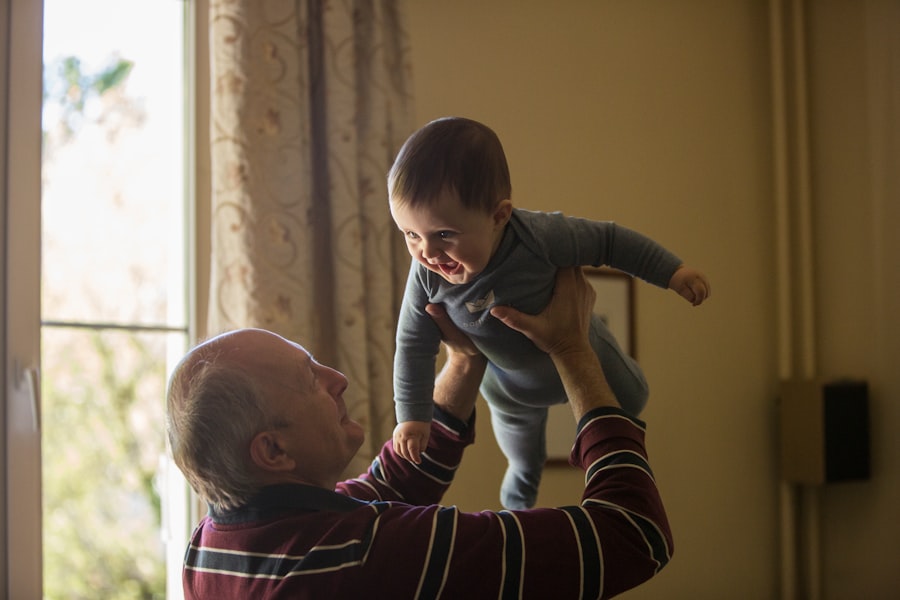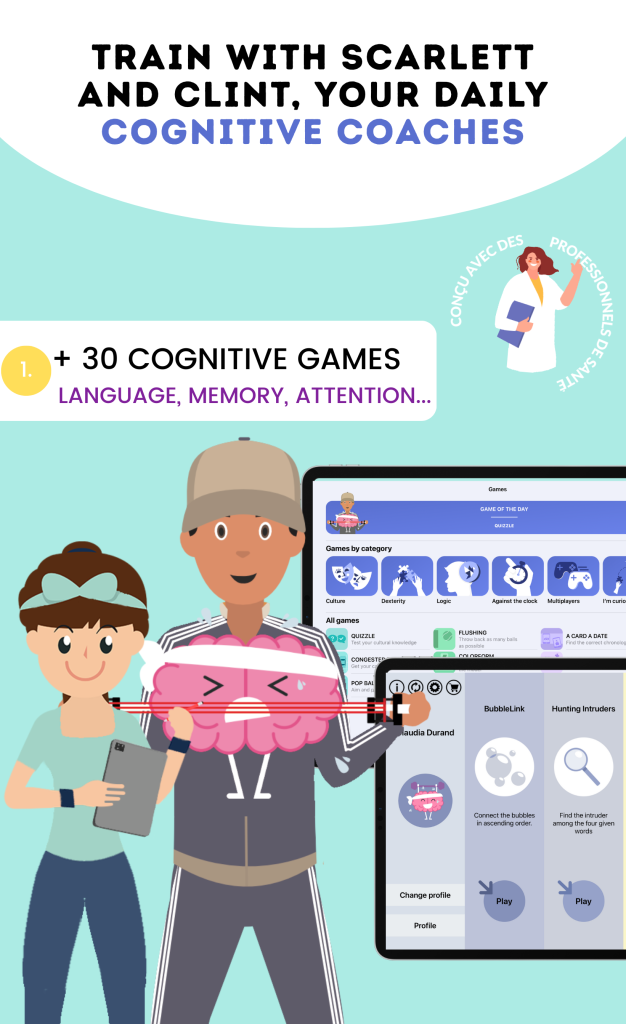The creation of stimulating activities for elderly people is of paramount importance for their well-being and quality of life. Stimulating activities can help maintain the physical and mental health of elderly people, prevent depression and social isolation, and promote a general sense of well-being. However, it is essential to understand the specific needs of elderly people and to use the appropriate tools to create activities tailored to their abilities and interests.
The tools in our box to stimulate seniors
There are a multitude of suitable tools for creating stimulating activities that help maintain engagement, mental and physical health of seniors. These tools are designed to meet specific needs and provide enriching experiences. Here is a selection of tools present in our box to encourage seniors to stay active and connected.
1. Board games adapted for elderly people
Board games are an excellent way to stimulate the mind while creating moments of conviviality. There are adapted versions of classic games, such as Scrabble, Monopoly, or Uno, which are designed to be easier to handle, with larger letters and numbers and a slower pace of play. These games promote not only cognitive stimulation but also social interaction, a crucial element for seniors.
- Concrete example: A group of seniors gathers for a game of Scrabble, which not only helps improve their vocabulary but also strengthens their social bonds while having fun together.
2. Puzzles
Puzzles are perfect for stimulating visual memory, concentration, and problem-solving. Depending on the level of difficulty and interests, one can choose puzzles with large pieces, soothing images, or family themes to enhance engagement. They are also suitable for reduced physical abilities, allowing seniors to work at their own pace.
- Concrete example: A senior who loves animal history may be offered a puzzle depicting species she particularly enjoys, encouraging her to participate while evoking her memories and passions.
3. Activity books
Activity books, such as coloring books, crosswords, or sudokus, are wonderful tools for maintaining cognitive activity and improving concentration. They offer a simple and accessible way to stimulate memory and keep some mental activity while having fun.
- Concrete example: A senior passionate about crosswords finds a daily challenge in her activity book, helping her keep her mind sharp while enjoying solving puzzles.
4. Adapted physical exercises
Physical activities, whether gentle or moderate, are essential for maintaining mobility and flexibility in seniors. Light muscle strengthening exercises, gentle yoga, walking, or light dancing are examples of physical activities that promote balance, coordination, and cardiovascular health. They are also an excellent way to reduce the risk of falls and maintain good posture.
- Concrete example: A session of gentle yoga, with simple movements and stretches, can be practiced in a group, stimulating blood circulation while strengthening social bonds.
5. Cognitive activities
Memory games, puzzles, quizzes, and other brain challenges are essential for maintaining the mental sharpness of seniors. They help work on short-term memory, concentration, and problem-solving. Memory games, for example, can be adapted to the cognitive abilities of seniors by adjusting the difficulty of the cards and facilitating their handling.
- Concrete example: A memory game with familiar images (such as family photos or vacation spots) is offered to a group of seniors to stimulate their memory while evoking good memories.
6. Social activities
Social interactions are crucial for the well-being of seniors. Discussion groups and group outings are perfect ways to encourage socialization. Activities like thematic discussions, debates, or meetings over coffee allow seniors to exchange ideas, share their experiences, and create bonds with others.
- Concrete example: A monthly meeting around a discussion theme (such as travel or family) where seniors share their stories and viewpoints.
7. Cultural activities
Cultural activities are an excellent way to stimulate the mind while promoting social engagement. Museum visits, shows, or exhibitions allow seniors to explore new horizons, learn, and appreciate various forms of art. These activities also provide the opportunity to socialize and discover common interests with other participants.
- Concrete example: A group of seniors participates in a guided tour of a local art museum, discovering artworks while sharing their impressions and engaging in discussions.
8. Technological activities
The use of technologies, such as computers or tablets, can also stimulate cognitive abilities and improve social connectivity. Seniors can learn to use educational apps, play online games, or participate in virtual meetings with their loved ones. These tools allow for a window into new experiences while staying connected to the modern world.
- Concrete example: A senior uses a brain games app on a tablet, practicing cognitive exercises while learning to handle a digital device, helping her stay connected and stimulate her memory.
Understanding the needs of seniors for tailored activities
Before designing activities for elderly people, it is crucial to understand their specific needs. Each senior is unique, and their needs may vary depending on their physical abilities, mental state, and personal preferences. Here are some key elements to consider for personalizing activities:
1. Taking into account reduced physical abilities
Seniors may suffer from reduced mobility, joint pain, or increased fatigue. It is therefore important to offer adapted physical activities that do not require too much physical effort. Exercises like tai chi or gentle yoga are excellent options for improving flexibility, strength, and balance while remaining accessible.
2. Considering memory and cognitive abilities
Cognitive disorders such as dementia or age-related forgetfulness require tailored activities. Simple memory games, puzzles, or quizzes can be particularly beneficial, as they stimulate cognitive functions while remaining sufficiently accessible.
3. Increased sensitivity to external stimuli
Seniors may be more sensitive to loud noises, bright lights, or agitation. It is therefore preferable to create calm environments conducive to relaxation, offering quiet activities like reading, coloring, or small group discussions.
Physical Activities
Physical activities are essential for maintaining the health and well-being of elderly people. They can help maintain muscle strength, balance, and flexibility, as well as prevent falls and chronic diseases such as heart disease and diabetes. To create stimulating physical activities for elderly people, it is important to choose exercises that are adapted to their physical abilities. This may include walking exercises, gentle yoga, tai chi, or light dancing. It is also important to encourage elderly people to participate in regular physical activities by creating a safe and welcoming environment.
Cognitive Activities
Cognitive activities are important for maintaining the mental health and cognitive function of elderly people. They can help stimulate memory, concentration, and problem-solving, as well as prevent cognitive disorders such as dementia and Alzheimer’s’s disease. To create stimulating cognitive activities for elderly people, it is important to choose games and puzzles that are adapted to their cognitive abilities. This may include memory games, puzzles, crosswords, sudokus, and brain games. It is also important to encourage elderly people to participate in regular cognitive activities by creating a stimulating environment and providing them with the necessary tools.
Social Activities

Social activities are essential for preventing social isolation and promoting a sense of well-being among elderly people. They can help maintain social relationships, strengthen the sense of belonging, and encourage the exchange of experiences and ideas. To create stimulating social activities for elderly people, it is important to choose activities that promote social interaction, such as discussion groups, group outings, group board games, or group artistic activities. It is also important to create a welcoming and inclusive environment where elderly people feel comfortable participating.
Cultural Activities
Cultural activities are important for stimulating the mind and nourishing the soul of elderly people. They can help broaden horizons, foster creativity, and encourage artistic expression. To create stimulating cultural activities for elderly people, it is important to choose activities that are adapted to their interests and abilities. This may include museum visits, theater performances, music concerts, art workshops, and reading sessions. It is also important to create a stimulating and inspiring environment where elderly people can fully engage in cultural activities.
Technological Activities
Technological activities are becoming increasingly popular among elderly people and can offer many benefits. They can help maintain social connectivity, stimulate cognition, and promote lifelong learning. To create stimulating technological activities for elderly people, it is important to choose tools and applications that are adapted to their abilities and interests. This may include the use of computers, tablets, smartphones, and specific applications for elderly people. It is also important to provide appropriate training and support to help elderly people use these tools effectively and safely.
Activity Evaluation
It is essential to evaluate the effectiveness of activities for elderly people to ensure they meet their needs and are beneficial for their well-being. This can be done by gathering feedback from participants, observing their level of engagement, and assessing the outcomes on their physical, mental, and social health. It is also important to make adjustments to activities based on feedback and the specific needs of participants.
Creating stimulating activities for elderly people is essential for their well-being and quality of life. By using the available tools and understanding the specific needs of elderly people, it is possible to create stimulating and tailored physical, cognitive, social, cultural, and technological activities. It is also important to regularly evaluate the effectiveness of activities and make adjustments based on the specific needs of participants. By using these tools and adopting a holistic approach, it is possible to create effective and sustainable activities for elderly people.





